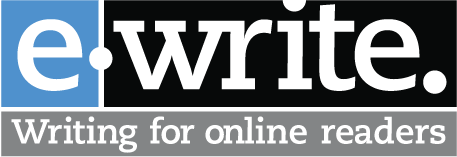 Over the last six months I’ve been involved in a dream-come-true project. For the U.S. Energy Information Administration (EIA), I developed a full writing curriculum—a set of eight different writing courses—and taught each of the courses at least twice.
Over the last six months I’ve been involved in a dream-come-true project. For the U.S. Energy Information Administration (EIA), I developed a full writing curriculum—a set of eight different writing courses—and taught each of the courses at least twice.
This project was heaven. I got to provide writing training to some of the best communicators in the government. This project enabled me to “go deep.” Instead of offering one course on one day to one group of people, I was able to provide a set of customized courses. EIA staff who attended these courses improved their “small picture” writing skills—punctuation, grammar, proofreading—and their “big picture” skills—plain language and conciseness. And lots of people signed up for more than one course. EIA has a total of 325 employees, and overall attendance in the Write Right courses was 391, so we had many repeat attendees.
About EIA
EIA “… collects, analyzes, and disseminates independent and impartial energy information to promote sound policymaking, efficient markets, and public understanding of energy and its interaction with the economy and the environment.” EIA publishes Today in Energy, the Short Term Energy Outlook, the Annual Energy Outlook and many other products used by citizens, journalists, and lawmakers. EIA is serious about publishing information that helps people understand energy. The agency has won numerous plain language awards, including:
- 2013 ClearMark Award from the Center for Plain Language for its 2012 Writing Style Guide. If you’re interested in excellent style guides, download the updated version, the 2015 EIA Writing Style Guide, which was the basis for one of the courses in the Write Right curriculum.
- 2010 Second Place Gold Screen Award from the National Association of Government Communicators for Energy Explained — a Guide to Understanding Energy and a First Place Award for Energy Kids.
Leadership for the Write Right project
To succeed, an extensive writing training project needs management support. The idea of offering a customized writing curriculum came from Gina Pearson, EIA’s Assistant Administrator for Communications. And backing for the writing curriculum came from the very top of the agency. Gina explains, “The curriculum required special initiative funding and had to compete in this process with many other worthy requests. Luckily our agency head [Administrator Adam Sieminski] has been a big proponent of getting our message out more successfully to a broader audience, and his support ultimately carried the day.”
Colleen Blessing, a senior editor at EIA and lead author of the agency’s Writing Style Guide, managed many of the day-to-day Write Right tasks, such as reviewing the draft course agendas, handling enrollment, tracking attendance, and serving as the in-house expert at each course. Colleen is right when she says, “The program doesn’t run itself.”
Branding the “Write Right” Curriculum
At the start of the project, I suggested that EIA come up with a brand name for the eight-course writing curriculum. A brand name conveys the idea that the individual courses are part of a set and makes it easier to market the courses. After rejecting some super-punny options—All Write Already and Write Here, Write Now—the team chose Write Right. We used the Write Right brand name at the start and end of each course, especially when we were sharing reminders about upcoming training.
Offering a Range of Writing Courses
Before I developed the eight courses, I worked with EIA’s Office of Communications to learn about the products EIA writers produce, the particular constraints placed on the agency, and areas where writers and their managers were struggling. To customize each course, I used EIA writing samples, adhered to the rules and guidelines in the EIA Writing Style Guide, and developed EIA-relevant hands-on writing activities.
Here’s a list of the eight courses in the Write Right curriculum. You can also see a detailed list of the topics for each course.
- Introduction to the EIA Writing Style Guide (1.5 hours)
- Policy-Neutral Writing at EIA (2 hours)
- How to Improve Your Writing Process and Your Documents (7 hours)
- How to Write in Plain Language for EIA Audiences (2.5 hours)
- How to Edit and Proofread Your Own Writing (3.5 hours)
- Grammar, Punctuation, and Usage Refresher (3.5 hours)
- For Managers: How to Edit and Proofread Someone Else’s Writing (3.5 hours)
- For Non-Managers: How to Edit and Proofread Someone Else’s Writing (3.5 hours)
Measuring Success
The last Write Right class was offered about eight weeks ago, so it’s still a bit too early to measure long-term successes. One clear success is that the curriculum attracted a range of participants with different writing responsibilities. Colleen Blessing explains, “Roles ranged from people who had just started working at EIA to senior managers. Many of the classes were mixed. Not all attendees were analysts or people you would consider writers.”
The high attendance numbers show that the courses were popular, and the participant’s comments on the evaluation surveys show that people who attended liked the writing training. Here’s a sampling of their comments:
- I thought this class was very helpful. I learned at least five things I didn’t know!
- This is a class that every employee can benefit from. Excellent instruction!
- I thought I knew a lot about writing, but this can help me convey the messages to people I don’t get through to.
- It was not boring. It had real world examples, and we do have to do this writing a lot, so it is useful.
- Great class. Should attend. Bring questions.
Interested in more from Write Right participants? I’ve posted a lot (OK, a ton) of course survey comments for your review.
EIA’s Lessons Learned About the Write Right Curriculum
I asked Gina and Colleen to reflect on the writing training project, and here’s some of their advice:
- From Gina Pearson: If possible, offer more than one session of each class—like we did—to accommodate more people’s schedules. Determine if there are subjects unique to your organization that merit having a specific class just on that subject. EIA is policy neutral in our analysis, meaning we don’t take sides or make policy recommendations on issues. We had a class specifically about policy-neutral writing that dealt with many aspects (including participating in social media) of that mandate.
- From Colleen Blessing: You might not know all the classes that need to be taught until you get started. We ended up adding the How to Edit and Proofread Someone Else’s Writing course for non-managers based on requests.
- Gina: Having a closed, managers-only class was very exciting. They really got into the subject and aired problems and solutions. It was almost like therapy.
- Colleen: One minor frustration was the last-minute cancellation of students who had conflicts. Always overbook classes to allow for attrition.
The Write Right curriculum project was a great success because EIA made a serious commitment—in time, money, and enthusiasm—to the goal of helping staff write better. As Gina Pearson says, “We’ve definitely sent a signal that the agency is taking writing quite seriously and considers it a top priority.” And, as we all know, becoming a better writer isn’t easy. Writing isn’t easy. There are no “easy wins” in writing training. People need multiple opportunities for learning, and lots of practice and feedback, to really grow.
Interested in a customized writing curriculum for your organization? Contact us. We’re eager to help.
Tags: Business Writing, Plain language, Workplace Writing, Writing training






0 Comments